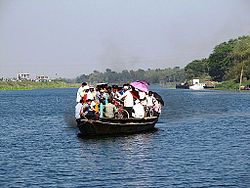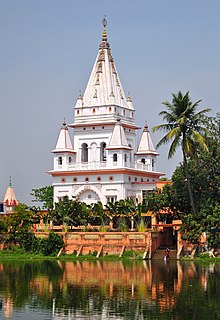Mayapur
This article has multiple issues. Please help improve it or discuss these issues on the talk page. (Learn how and when to remove these messages)
|
Mayapur
মিঞাপুর | |
|---|---|
 The Ganges river at Mayapur | |
| Coordinates: 23°26′18″N 88°23′34″E / 23.4382755°N 88.3928686°E | |
| Country | |
| State | West Bengal |
| District | Nadia |
| Languages | |
| • Official | Bengali, English |
| Time zone | UTC+5:30 (IST) |
| PIN | 741313 |
| Telephone code | 91 3472 |
Mayapur, previously known as Miyapur (Bengali: মিঞাপুর) is a place situated adjacent to Nabadwip, at the confluence of two rivers, where the waters of the river Jalangi mix with the Ganga. It is located about 130 km north of Kolkata within Nadia district, West Bengal, India. Along with Nabadwip, it is considered a spiritual place by the adherents of Sanatana Dharma, also known as Hinduism.[citation needed]
Etymology
The word Mayapur derives from Minyapur (Bengali: মিঞাপুর) [Miñāpura], the Bengali name of a villages, Known as Muslim inhabited village, specially for the settlement of Muslim fishermen.[1][2]
About

It is said to be the birthplace of Chaitanya Mahaprabhu.[by whom?] The headquarters of ISKCON is situated in Mayapur. It is said that God Krishna appeared along with his brother Balarama, as Chaitanya Mahaprabhu and Nityanand Prabhu. These two brothers appeared just for the fallen conditioned souls of this Kali-yuga to bestow on them the greatest blessings of Harinama Sankirtan based on the teachings of Bhagvad Gita and Shrimad Bhagavatam. Along with their associates, the Pancha Tattva, they distributed the divine Love of Godhead to anyone and everyone without seeing any qualifications or disqualifications. Mayapur is where the Material and Spiritual Worlds meet. Just as there is no difference between Lord Chaitanya and Lord Krishna, similarly there is no difference between Shridham Mayapur and Vrindavan.[citation needed]
Memorials

The main attraction in Mayapur is Srila Prabhupada's Pushpa Samadhi Mandir, a memorial to ISKCON's founder. The main shrine is surrounded by a museum depicting Srila Prabhupada's life,[3] using fiberglass exhibits. In 2002, the International Society of Krishna Consciousness was planning to construct a garden in memory of George Harrison.[4] Another must-visit is the Mayapur Chandrodaya Mandir. This temple has 3 main altars, Sri Sri Radha Madhava, Panca-tattva and Lord Narasimha Deva. These Pancha Tattva deities are the largest deities of Pancha tattva in the world. The Panca-tattva comprises Sri Chaitanya Mahaprabhu, Nityananda Prabhu, Advaita Acharya, Gadadhara Pandit, and Srivas Thakur.
Gaudiya Vaishnava temples

There are a number of Gaudiya Vaishnava organizations in Mayapur, such as the Gaudiya Math. The town is heavily centered on this particular Vaishnava religious tradition, officially known as the Brahma-Madhva-Gaudiya Sampradaya, with temples devoted to Radha and Krishna or Gaura-Nitai throughout.[citation needed]
The Gaudiya-Vaishnava devotees every year circumambulate the various places of Lord Chaitanya's pastimes in the group of nine islands known as Navdvip. This Parikrama takes about 7 days. This event takes place around the Gaur Purnima Festival (Appearance Day of Lord Chaitanya). Devotees from all over the world come to Mayapur for this auspicious Parikrama to celebrate the Lord's Divine Appearance Day.[citation needed]
See also
Footnotes
- ^ Sen, Dinesh Chandra (1934). Brihat Banga Vol. 2.
- ^ Bhatia, Varuni (2017). Unforgetting Chaitanya: Vaishnavism and Cultures of Devotion in Colonial Bengal. Oxford University Press. ISBN 978-0-19-068624-6.
- ^ "Guide for winter celebration at Mayapur".
- ^ "In Brief: Nickelback, Slayer: Nickelback: Rolling Stone". rollingstone.com 29 March 2002. Retrieved 21 February 2009.
References
- Dasa, Shukavak N. (1999), Hindu Encounter with Modernity: Kedarnath Datta Bhaktivinoda, Vaiṣṇava Theologian (revised, illustrated ed.), Los Angeles, CA: Sanskrit Religions Institute, ISBN 1-889756-30-X, retrieved 31 January 2014
{{citation}}: Invalid|ref=harv(help) - Fuller, Jason Dale (2005). Bhaktivinode Thakur and the transformation of religious authority among the Gauḍīya Vaisṣṇavas In nineteenth-century Bengal (Ph.D.). University of Pennsylvania. UMI Microform 3179733. Retrieved 8 June 2014.
{{cite thesis}}: Invalid|ref=harv(help)



